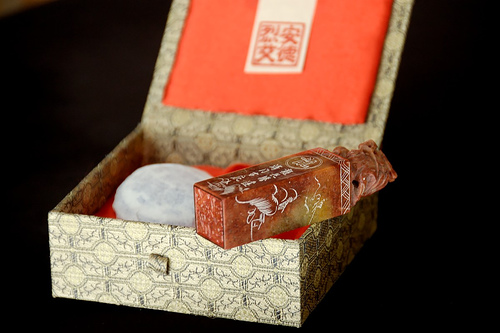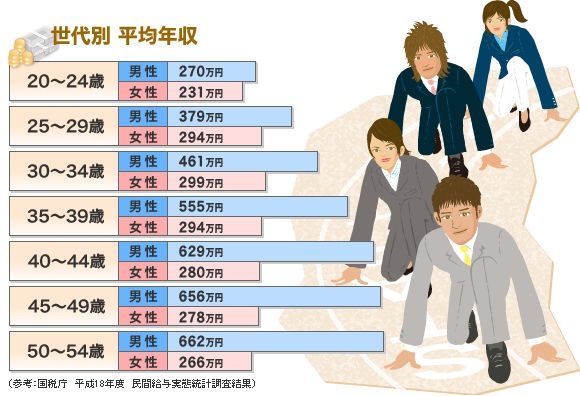
The location for the Chinese-Japanese Friendship Group’s speed dating event seemed like a place where love goes to die. From the outside it looked like a local convenience store, the kind where you can easily purchase 50 cent baijiu (rice liquor) and tar filled cigarettes–maybe even a cell phone charge card. If it weren’t for the hand written sign taped to the wall adjacent to the shop keep, we would never know that a dating event lie in wait just beyond the foul stench of the convenience store’s stinky tofu, and up the stairs from the grime filled storage room.
“I’m scared, Lingling” I turned to my raised-in-Japan-can’t-speak-Mandarin-well-but-has-perfect-Japanese-Shanghainese-friend, Lingling, who heard about the event on a Japanese message board.
“Maybe this wasn’t such a good idea,” she looks up the stairs in hesitation. “What do you think, Mary? Make a run for it?”
We stand in silence. The sign taped to the wall falls to the floor.
“You know, we’re here already, maybe we should just go up and check it out.”
“You’re right,” Lingling nodded. “Let’s just go up and see what it’s like.”
Lingling and I had just split up from our Shanghainese boyfriends, and while the two of us weren’t in desperate need of a date we were looking for the chance to maybe—just maybe—meet a half decent guy in Shanghai.
How wrong we were.
If we thought the convenience store exterior was bad, we were ill prepared for the interior. We found ourselves in a dimly lit coffee shop wallpapered in brown argyle reminiscent to my grandmother’s living room. Random and broken antiques dotted the tables in an effort to provide ambiance, but failing miserably. A strange, musky cologne scent (also similar to my grandmother) permeated the air. It was dark and gloomy. The place was near empty.
Just as Lingling and I were about to bolt, the organizer of the event dragged us to the far end of the room where we found ourselves face to face with 15 men and 15 women. We were given name tags and two sets of stickers, 5 blue and 5 red, and told to stand in a line with the women, facing the line of 15 men head on.
There have been many awkward and possibly embarrassing moments in my life.
But this speed-dating thing? Takes the cake.
The Players
I look around to check out the other contenders.
On the ladies’ side we had 17 fairly pretty Chinese women; one lone, super kawaii Japanese girl; myself, and a big, black lady that spoke little Chinese and no Japanese (just how the hell did she find this place?).
The men were mostly Japanese (surprisingly), but with a good mix of Chinese thrown in. No foreigners. There was a man with a cane and a cape. I counted at least four nerds with pocket protectors, shifting their eyes from the ground to the girls while fumbling their fingers. The others were typical Japanese salarymen with black slacks, button up white shirts and perfect hair.
On the end was a pretty Japanese boy that I called Jun Matsumoto, because he looked like the main dude from the boy band Arashi. His expression was apathetic and disinterested, and I could feel the ladies swoon over him.

It was an interesting crowd.
Survival of the Stickers
“Hello everyone and welcome,” our host smiles. “Now first of all, we’re going to have the line of women go up to each man and introduce herself for a few seconds. Tell these handsome studs your name, your age, your line of work–the usual.”
Extremely awkward; but doable, I thought.
“Introductions alone are boring,” our host continues. “That’s why we gave you two sets of stickers. After the quick line of introductions, we would like you to hand out your red stickers to the men you find most attractive. Remember, you only have five stickers, so use them sparingly.”
I choke on my coffee and start coughing. Lingling looks at me in horror.
“Then,” she continues. “It will be the men’s turn to give stickers to the ladies.”
“Lingling,” I turned to her and whispered in English so no one could (hopefully) understand. “What the hell? We’re judging each other on looks alone? This makes me really uncomfortable.”
“I don’t like it,” Lingling looks around. “Unbelievable.”
There was no turning back. Lingling and I braced ourselves for 15 awkward conversations and took a step forward.
War of the stickers
In the end, I gave my stickers to no one. Blame my morals, or my upbringing, or just plain call it a way to rebel against this ridiculous “game”—but I just couldn’t rank these poor guys on good looks alone. I didn’t have it in me to split the contenders into have-stickers and have-nots.
The men, on the other hand, were more than glad to rank us ladies according to sticker.
The results?
Chinese women, black girl and me: 0 red stickers
Lone, kawaii Japanese woman: 40 red stickers
“Looks like we have a winner,” the host smiled and brought the Japanese woman to the center of the room. She blushed. “This lovely young lady is the most popular of all!”
This felt like a nightmare right out of a high school popularity contest.
More than that, it confirmed my worst fears:
Asian men would rather have a cute, Japanese girl than a westerner.
“Now then,” the hosts continued. “Let’s start the speed dating! Ten minutes for each table!”
“You have to be fucking kidding me,” I say out loud in English.
Let’s just say, my outburst didn’t help in the second battle of the stickers.
The Results
I won’t bore you with the details of the 15 mini-first-dates I had. They ranged from awkward bouts of silence to men that were utterly disinterested in western women (and even said it to my face). The Jun Matsumoto boy was actually half decent; a graphic designer sent from an ad agency that had previously lived in Scotland and spoke somewhat good English. Another man donning a green cape and top hat actually turned out to be a famous architect from Hong Kong that had self taught himself Japanese (which was just as good or better than mine). He had a wife and two kids and wasn’t there to find a date; but rather, accompany a shy Chinese friend that found it hard to keep eye contact with the female species.
Following our clumsy dates, the host rounded us up in line fashion once more and made us face off. Take out your blue stickers, she commanded.
I’m sure you can guess the rest.
A part of me was secretly hoping that maybe, just maybe, the men had looked past appearances and actually managed to find an emotional bond with one of the other sixteen women during our mini dates. Another part of me just wanted to throw the stickers at the host’s face for organizing such a confidence-wrecking event.
In the end, I stayed.
And in the end, the results were:
Chinese women, black girl and me: 0 red stickers
Lone, kawaii Japanese woman: 20 blue stickers
Again, the host took her by the hand and crowned her Queen of the prom. I mean, winner of the speed-dating beauty contest. Or whatever this event was. I didn’t even know what the whole purpose of this gathering was anymore.
The men started to crowd around kawaii Japan woman like monkeys in mating season. Lingling and I saw that as our cue to leave. We tossed our blue stickers to the ground and left as quickly as we could, saying a word to no one.
The Hardships of Dating in Shanghai as a Woman

I won’t lie.
I felt pretty goddamn awful after that event.
I didn’t just leave the event. I ran. I ran down the stairs, past the stinky convenience store and straight onto Nanjing Road. I fled the venue and stopped in my tracks when I was as far as I needed to be. Skyscrapers crowded in all around me. The famous department store 818 on Nanjing Road was on my left, the subway station on my right, and floods of Chinese shoppers all around me. I looked up to the sky; it was cloudy without a hint of sunlight, a swirl of grey and white.
Was that event the cold, hard truth punching me in the face?
Am I simply undesirable here?
In Shanghai (really, all of Asia) finding a decent man, or partner in general, can be a difficult task.
As a western woman, we have two choices in Shanghai: Ex-pats or the local crowd. Most young ex-pats going to Shanghai aren’t looking for someone to pop the “I do” question to. In most cases, the foreigner’s stay in Shanghai is temporary—which is also how they prefer their relationships.
The local men, on the other hand, are the exact opposite: They want to settle down, and they want to settle down NOW. Most western women in China may not be adverse to the idea of marriage or commitment, but we usually aren’t in the same kind of rush as the locals. Plus, locals are more hesitant to marry foreigners mostly due to language barrier, cultural incompatibility, and possible conflicts with the in-laws.
Between the party hard ex-pats and Chinese men are quick to bend the knee, finding a happy medium in Shanghai can feel like wading through a kiddie pool.
Bottom line: Going to a speed-dating event where I was rejected by 15 men in the span of 5-sticker-posting-minutes brutally reminded me that Asian men aren’t interested in me—and it definitely wasn’t a confidence booster for post breakup Mary.
“There you are, Mary” Lingling ran up beside me and patted me on the shoulder.
“Are you alright?”
“Well…”
“Because I’m not!” She shouted. “That was goddamn terrible! I can’t believe Chinese people can construct an event like that—it’s so—so—demeaning!! And that Japanese girl wasn’t even pretty! In Japan she would totally be below average.”
I laughed and looked up at Lingling, her face red in anger.
“Yeah!” I shouted and let it all out. “Those stupid Asian guys! They just want a stupid, giggling, Japanese bimbo from their AV fantasies!”
“Exactly!” Lingling laughs. “Plus all those guys were weirdos, Mary. None of them were interesting at all. Really. Don’t let it get you down.”
“You’re right,” I smile. “Fuck ‘em.”
“Fuck ‘em all.”
We pause.
“Let’s get some beer,” Lingling claps me on the shoulder as we walk toward an open taxi. “I think the Kaiba near here is still doing happy hour.”
“You read my mind, Linging.”
My motto in life?
No matter what happens, as long as you have beer and good friends—you can overcome anything.

Dating abroad can be tough, but having good friends to help you through troubling times might unexpectedly guide you to that person you’ve been waiting for.
It sure did for me. A few, short weeks later a certain man—Chinese, even—found his way to me.
And I would definitely give him all of my red and blue stickers.


































